The usual practice is to make ’em bigger – and more expensive.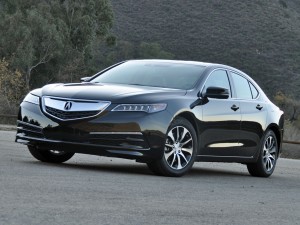
Here’s an instance of the opposite.
The TLX is a smaller car than the car it replaces (the TL) and it comes standard with a four cylinder engine (the TL came standard with a V6) which is probably why it costs so much less to start: $31,695 vs. $36,030 for the base trim TL (RIP).
By dropping the price, Acura hopes to straddle the gap between non-luxury-brand sporty sedans like the Nissan Altima and Mazda6 (which don’t offer all-wheel-drive) and the entry-luxury stuff like the BMW 3 and Audi A4 (which do offer AWD but generally cost more when so equipped).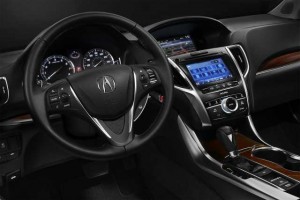
Like all Acuras, the TL is based on a front-wheel-drive layout, but it offers four-wheel steering – something neither the lesser-badged (and FWD-only) Nissans and Mazdas, et al, offer.
Nor the more expensive prestige-brand BMWs and Audis.
And the TL’s standard engine – while not turbocharged (as most of the entry-luxury cars’ fours are) is nonetheless much stronger than the also-not-turbocharged fours that come standard in cars like the Mazda6 and Altima.
The TLX is Acura’s new mid-sized (but slightly downsized) luxury sport sedan.
It slots in between the compact-sized, entry-level ILX sedan and Acura’s flagship sedan, the full-size RLX.
It is smaller overall than the TL which it replaces – but much less expensive. Base price, as above, is $31,695 for a front-wheel-drive model equipped with the standard 2.4 liter, four cylinder engine and eight-speed automated manual transmission.
A top-of-the-line TLX with the Tech Package. 3.5 liter V6, Super Handling All-wheel-Drive (SH-AWD) and nine-speed automatic lists for $44,800
WHAT’S NEW
The TLX was added to Acura’s lineup last year as an all-new model. The ’16 carries over essentially unchanged.
Base four cylinder engine is not turbocharged – but isn’t a weakling.
Dual clutch eight-speed automatic with torque converter (explained below).
Four wheel steering – or all four wheels driving.
Attractive pricing; buy a luxury-brand, AWD-equipped sedan for about what you’d spend on a loaded FWD Maxima.
Or a not-loaded BMW 3.
Back seat legroom is way down vs. the old TL
Unavailable with a manual transmission.
To get AWD, you have to buy the V6.
High-tech features like the four-wheel-steering system might mean high-cost repairs down the road.
UNDER THE HOOD
It’s not surprising to find a four-cylinder engine under the hood of the new TLX.
Not so much because the market is clamoring for it. The government is pushing it. Not directly; there is no federal requirement that cars be fitted with smaller engines. But the federal government’s mandatory minimum fuel efficiency requirement – CAFE – is now set at 35.5 MPG on average. The only way to meet that mark is to sell more smaller engines. Or rather, the only way to be able to sell any larger engines is to sell a lot of smaller engines, the smaller engines’ higher mileage balancing out the larger engines’ lower mileage (each automaker’s “fleet average” CAFE number is calculated by averaging the mileage of all the cars it sells).
This is why even luxury-brand cars now routinely come standard with small four-cylinder engines rather than the previously typical big sixes (this includes the outgoing TL, which came standard with a 3.5 liter V6, with an even bigger 3.7 liter V6 available as an option).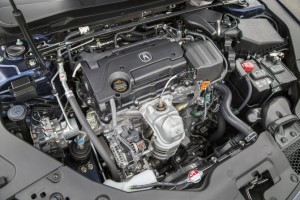
What is surprising is that the TLX’s standard 2.4 liter four isn’t turbocharged – as most other entry-luxury sport sedan fours are.
Nonetheless, Acura manages to squeeze 206 hp out of it, which is in the ballpark of the power made by the turbocharged fours in competitor vehicles and certainly class acceptable.
This engine is fitted with Acura’s iV-TEC variable valve timing (lift and duration) system. Honda – Acura’s parent company – is world-renowned for high specific output/small displacement engines. Think of Honda sport bikes; the same know-how manifests on four wheels as well as two.
The peppy little four is paired with a new dual-clutch eight-speed automatic with multiple driver-selectable modes and rev-matching downshift capability plus a torque converter – which is not common.
Some tech: A torque converter uses hydraulic pressure to multiply the engine’s torque at low engine speeds, which gets the car moving more quickly when accelerating from a dead stop. All conventional automatics have them, but most automated manuals don’t – and so (typically) feel a little sluggish when accelerating from a standstill.
Acura incorporated a torque converter into the design of its automated manual to address that problem. The four-cylinder TL can do the 0-60 run in about 7.3 seconds.
But the DSG’s inherently more efficient design (vs. a conventional automatic) also helps the four-cylinder TL deliver very good MPG numbers: 24 city, 35 highway. This is a big improvement over the old V6 TL’s 20 city, 29 highway.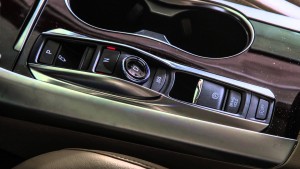
Optional is a new-design 3.5 liter V-6. This is not a carryover engine. It is direct-injected and high-compression (11.5:1) and features both i-VTEC and Variable Cylinder Management (VCM) which automatically shuts off three of the six cylinder during light-load/cruise driving to maximize fuel efficiency.
This engines makes 290 hp (vs. 280 for the old TL’s less sophisticated 3.5 V6) and manages to almost match the mileage stats of the 2.4 liter four: 21 city, 34 highway for the FWD version.
Models equipped with the V6 and the optional Super Handling All-Wheel-Drive rate 21 city, 31 highway – better than the ’14 TL with front-wheel-drive (the TL with AWD was a guzzler: 18 city, 26 highway).
The V6 is paired with an also-new nine-speed automatic, sourced from ZF.
It’s not a dual-clutch automated manual, but the range of possible forward gears allows for closer/sooner upshifts – which is part of the reason for the new TLX V6’s also-excellent EPA numbers.
The SH-AWD system can kick power to individual wheels – or wheels in pairs – as needed to maintain traction and enhance stability. There is an LCD display in the main gauge cluster that shows you the power split, in real time.
SH-AWD is an upgrade over the typical AWD system in that it provides a practical assist on bad weather days (rain and snow) as well as a performance assist during high-speed cornering.
The SH-AWD system is, however, only offered with the V6.
But if you buy the 2.4 liter engine (or the V6 with FWD) you’ll get Precision All-Wheel-Steering (P-AWS) included. The system does what it sounds like it would. Instead of directional control being a function of the front wheels only, electric motors adjust the angle of the rear wheels to assist in the curves. This makes the TLX easier to steer at low/normal speeds as well as ups the handling ante when you’re running faster.
Less engine (size-wise, at least) and more gears to leverage the available power sounds like a mixed bag on the face of it. Fun, certainly – in the way that a motorcycle is fun. A bike’s drivetrain is always doing something – revving, shifting – and that engages you in the process.
On the other hand, riding a bike for long periods – revving and shifting – isn’t for everyone.
But don’t worry, the TLX’s four – though it can sing like a liter bike’s four when you want it to – doesn’t need to in order to maintain the pace. Part of the reason for this being the technically brilliant eight-speed transmission that’s paired with it. Like other such transmissions (e.g., the VW/Audi DSG) it is an automated manual transmission, with electronically controlled clutch engagement. Two clutches, in this case – one set engaging/disengaging the even forward gears (2, 4, 6 & 8) another the odd (1, 3, 5 & 7), which Acura says cuts down shift intervals significantly, for both quicker-feeling and more efficient shifting.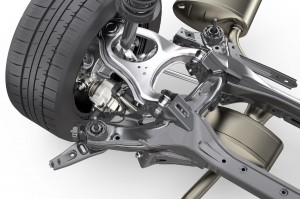
But the key thing is the box’s torque converter – a feature of conventional automatics that few (if any) other-brand automated manuals on the market offer.
If you’ve driven other DSG-equipped cars, you may have noticed they take a moment to get going when you floor it from a dead stop. It’s because they don’t have a torque converter. It takes a moment – not long, but noticeable – for the engine to build speed and thus, power. The torque converter lets the engine rev up faster, so it builds torque sooner. So how come everyone else doesn’t use a torque converter? In a word, slippage. The very quality that lets the engine rev/build power when you floor it from a standstill also (historically) entails an efficiency loss, which is why automated manuals and continuously variable (CVT) automatics have become so commonplace.
The automated manual combines the efficiency of a manual transmission with the ease of use of an automatic. But without a torque converter, off-the-line (and stop and go traffic) performance hasn’t been as good as either the manual or the conventional automatic with a torque converter. Acura’s solution – adding a torque converter to their automated manual – takes care of that.
If you shop this car, try the 2.4/eight-speed combo before you buy. I’m not saying don’t buy the V6. I’m just advising you not automatically rule out the little engine, thinking it’s an economy engine.
It is – but it isn’t.
It’s also unique in this class for being paired with a a four-wheel-steering system (P-AWS), which automatically (electronically) alters the toe angle of the rear wheels to make the car more maneuverable at low speeds as well as corner more controllably at high speeds. From the driver’s point of view, it’s unnoticeable – in the sense that you can’t tell when the rear wheels are changing their angles. It’s an upgrade over the usual/typical stability control system – which reacts to instability by pumping the brakes. Acura’s system enhances stability by altering geometry. It’s pretty neat.
The system comes standard with both engines, too.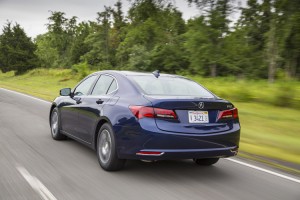
The optional SH-AWD system (V6 TLXs only) is similar in concept to the previous SH-AWD system that was available in the TL. It features “torque vectoring,” or the routing of power not just front to back under acceleration also to individual wheels when cornering – but the weight of the system has been cut down by 25 percent.
This – along with the upgraded V6 (direct injected) – accounts for the improved performance and fuel economy.
The previous TL handled well, but it was heavy – and thirsty.
This fixes that.
Acura began as a kind of anti-Lexus.
The former being for the young and affluent, the latter for the old and affluent.
But over time, Acura developed a beer gut – while Lexus edged ever-sportier.
The new TLX – and other new Acuras – is an attempt to return the brand to the Integra (and NSX) zeitgeist of the ’90s.
It is lower – and much leaner – than the middle-aged-spread TL: 3,483 lbs. vs. 3,741 lbs., 5.8 inches off the ground vs. 6.1 and an inch less wide through the hips (73 inches vs. 74 previously). The wheelbase remains the same, but overall length has been reduced by almost four inches (190.3 vs. 194 inches). Narrow – and long – LED headlights and a less-big version of Acura’s “pewter bar” grille accentuate the trimmed down/toned-up look of the TLX.
There is a price to be paid for youthful good looks, though.
Headroom up front drops by more than an inch (37.2 inches vs. 38.4 in the TL), it’s a bit tighter, shoulder room-wise (57.5 inches now vs. 58.2 before) and – the big one – backseat legroom has been lopped down to 34.5 inches vs. 36.2 in the TL.
Still, this is in the ballpark when you compare the TLX’s stats with those of others in its price range, such as the BMW 3 and Mercedes CLA (which is a compact sedan).
The TLX is smaller overall (and inside) than the old TL, but it’s still mid-sized.
Just leaning a bit more in the direction of compact-sized.
THE REST
For a long time, Acura was somewhat hobbled relative to the Big Name Players in the luxury segment because its cars were based on front-wheel-drive layouts (with AWD optional) whereas – for the most part – the others were based on rear-drive layouts.
The latter was perceived as being more prestigious as well as superior in terms of handling/driving feel (the weight of the car being more evenly distributed) while the former was looked upon as – fundamentally- an economy car layout.
But this is no longer true – or at least, not as true as it used to be.
In the first place, it is very hard (on the street, within legal road speeds) to tell the difference, handling-wise, between a FWD-based AWD car and RWD-based AWD car. In addition, many prestige brand cars are AWD or offer AWD.
Also, the FWD-based layout no longer appears to be a marketing liability.
Mercedes’ new CLA sedan – which is FWD/AWD – is doing very well. Well enough, in fact, that Mercedes has already spun-off another FWD-based vehicle – the GLA – using the same basic architecture. Expect BMW to follow suit.
Cadillac is already there.
I did a separate article (see here) about the TLX’s available semi-self-steering technology. It’s formally called Road Departure Mitigation and uses cameras built into the front end to orient the car’s position in between the yellow and white lines. When engaged, the system will automatically steer the car (within certain boundaries) to keep it within its travel lane. The driver feels this as a light – but noticeable – assist. It is possible – though not recommended – to take both hands off the wheel and watch the car drive itself. Just be mindful, because the car can’t take sharp curves on its own and if the cameras can’t see the painted lines, the car will wander.
It’s a preview of things to come.
Acura has also added a small but helpful feature it probably copied from Kia/Hyundai – whose cars had it first: A button near the shifter you can press when stopped at a red light that will apply the brakes and hold the vehicle stationary without the need to take it out of gear – and without the need for you to keep your foot on the brake.
Press the button again to release the hold and be back on your way.
Selecting gears is also a push-button deal.
TLXs with the SH-AWD system come standard with auto-stop/start – a gizmo that is quickly becoming a de facto standard in new cars generally. See earlier discussion about fuel economy pressures emanating from Washington to grok why this is so. The system can be turned off, thankfully. 
The car’s seat heaters are excellent – and the optional 455 watt, 10 speaker ELS/studio sound system is superb. The On Demand Multi-Use Display (ODMD) is a mouthful to say but not a PITAS. Tap and touch, legible graphics and an attractive display. The USB and HDMI ports are both located driver-accessibly (with the car moving) in front of the shifter, at the bottom of the center stack.
THE BOTTOM LINE
When battleships fired their big guns, the object was to straddle the enemy ship. Not overshoot – or undershoot.
We’ll see whether Acura’s gunnery is accurate!
If you value independent media, please support independent media. We depend on you to keep the wheels turning!
Our donate button is here.
If you prefer to avoid PayPal, our mailing address is:
EPautos
721 Hummingbird Lane SE
Copper Hill, VA 24079
PS: EPautos stickers are free to those who sign up for a $5 or more monthly recurring donation to support EPautos, or for a one-time donation of $10 or more. (Please be sure to tell us you want a sticker – and also, provide an address, so we know where to mail the thing!)




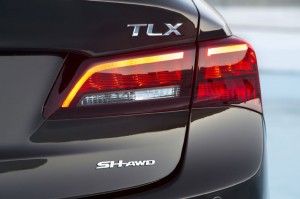



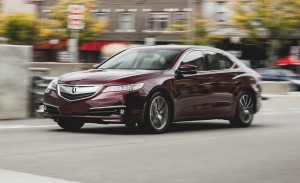









“Pitting one bureaucracy against another is one of the best ways to gain liberty. We should not expect liberty to be handed down by politicians. Much as we hate bureaucracy, bureaucracy is fundamental to the maintenance of liberty. That is because there is always more than one bureaucracy inside any government. If you can find a way to maintain your liberty by persuading one bureaucracy to resist the extension of power by another bureaucracy in your life, you at least have a running shot at securing some degree of liberty. Competing bureaucracies were about the only way that people could gain a small degree of liberty inside the Soviet Union.”
Gary North teaches high school history online through movies, e.g., All the President’s Men.
‘Follow the money’ did not originate w/Deep Throat, or even w/Woodward & Bernstein. It was added to the movie script by a screen writer.
http://www.garynorth.com/public/14905.cfm
Speaking of Honda, do you know if you’re going to be reviewing a new Ridgeline? I know its reputation is like having a fat girlfriend, but for those of us who don’t live on a ranch but want to go up in the hills once in a while it has a certain appeal.
Yes – absolutely!
They are supposed to send me one in the fairly new future.
Former Ridgeline owner here. The fat girlfriend isn’t so fat anymore. But she’s not nearly as interested in going camping as she used to be either.
The previous model was based on the MDX (technically, the MDX was based on the Ridgeline) but you’ll read lots of fan-boi comments about how it was really a minivan (not true). But the new model is based on the family-hauler Pilot. And will be used as a platform for the new Odyssey. So technically yes, it’s a SUV with a truck bed, or a minivan with a hell of a sunroof. With a 1600 pound load capacity and a trunk.
What it’s not is a rock-crawler. Lots of anguish from people over this decision, but if the Ridgeline takes over the position that the Ranger once held (general utility truck that anyone can drive), it’ll be a success. So … a city truck.
Eric, you’ll hate it because it isn’t your 1999 Frontier. 😉 But it’ll have modern crash performance, decent gas mileage, tons of utility, and won’t be weird-looking anymore. One thing for you to pay attention to is the fingerprint-magnet touchscreen. I hate touch controls – give me real buttons.
Hi Chip,
Actually, I expect to like it. I was a fan of the original (see the old reviews; they’re still available on site). Rock-crawling is something few people ever do and there are Wrangler Rubicons for that. What most people want from a pick-up is the ability to… pick stuff up.
To me, the Ridgeline is a kind of modern take on the El Camino concept. A car that’s useful. Even more so, given the bigger cab.
As for the saaaaaaaaaaaaaaafety crap… well, you know how I fell about that! 🙂
eric, let’s not compare a Ridgeline, which I like the new look much better looking more like an Avalanche but an Elco it ain’t. Let’s see a Ridegeline pull a boat out of the water or in the case of mine, pull a huge Dodge “family, good times van” with a tandem axle boat trailer with boat in tow out of a lake so low the trailer was caught on the end of the concrete ramp like my Elco did, leaving two big black streaks while the Dodge did it’s revving best against a shitty torque converter. Those people were mighty grateful since it was nearly dark and we’d just gone by to see how low the lake really was. BTW, if you double ski rope enough times it has some impressive strength.
Or like friends who had Elco’s, pull fifth wheel RV trailers.
Elco’s would still be around had they made crew cab versions.
“Elco’s would still be around had they made crew cab versions.”
Maybe, maybe not. I think some people just bought them because they didn’t have a back seat, but they didn’t want (or the wife wouldn’t let them have) a Vette.
The lack of a back seat was a plus for the nimble sporty truck that had a 1/2 T rating. And probably a back seat model would have been a slow seller but it might have caught on.
If I were a body man I would have built a crewcab Elco long ago. But the frame would need to be beefed up. One of the best grafts I ever saw was an Elco back and a Caddy front. I had to drive around the block and stop and look at it. Take that big Caddy with the semi-Limo look(I forget the model) to it and graft an Elco rear on it with that huge Caddy engine….that would have been a winner.
8, I remember back in the 80s, seeing a Cutter Bill’s catalog,with something I could never afford on every page…anyways, one page was a Rolls Royce pickup truck. It looked like maybe late 50s, early 60s Rolls from the view of the front end. Custom built by Rolls Royce for a Texas oil millionaire, I suppose. It was an item that Cutter Bill’s had bought for resale.
Man, now that was some pickup.
Might have been a “flower car:”
http://www.jalopyjournal.com/forum/threads/blues-brothers-cadillac-el-camino.765264/
Cab Calloway’s character drove one in The Blues Brothers.
This was a real Elco rear grafted onto a Caddy…..in Merkel, Tx. no less.
Yeah, those flower cars were the ticket, an actual Caddy pickup truck. There was one for sale in my hometown when I was in high school, a ’56, black with chrome rails.
One like it appeared in “Alice’s Restaurant”.
Evidently you Can get anything you want…..
Hi Eight,
Sure! Assuming, of course, it wasn’t one of the Elcos that had the two barrel V6! 🙂
eric, ever see a 4WD Elco? And now with IFS it wouldn’t even set up that high. That would be the ticket for lots of old country boys(and girls). It’s the front to rear weight ratio that makes them great.
I took the air shocks off mine and used coil-overs with T/a pieces in the front end with much lower profile tires. I lost nothing in cargo capacity but gained a lower rear, virtually even with the front.
And to be clear on a rear seat, it could have been done with side facing jumpseats. We’ve hauled 4 people in one. With the right cushions the rear passengers couldn’t be seen.
Yes – but it was a jacked-up/modified one.
They never made a factory 4WD, did they?
I found a really nice, completely stock one not far from here. It’s silver, has a 350/4-barrel and three-speed automatic. Only $10k.
I wish I weren’t broke!
No not factory, generally 1/2T or Blazer running gear all the way around. Just off the top of my head it would seem a IFS version would be possible without so much added height. Then again, the engine saddle might have to be moved or simply build a custom. It might be done using a shaker hood or a large scoop for engine clearance with a remote air cleaner like GM 6.5 Turbo diesels had(and most every pickup since).
Since I run a lot of back roads I see a great amount of automotive bric a brac. On one road about a quarter mile apart there is a house with 3 identical white Suburbans in the front yard, all running it would appear. Then they have a metallic red of the same 90’s vintage in the driveway beside a late model.
Right down the road, there is an old Dodge pickup of the 4WD flavor with large tires and some amount of lift…..in progress, body and apparently engine and drivetrain also. In the backyard, there is an old Dakota with huge tires and obvious lift sitting on a car trailer still tied down.This same house used to have an old silver Merc of probably early 70’s vintage, but now gone as it had a “for sign” on it.
I know of two other farm houses with old Merc’s sitting there, one a 60’s era diesel that just looks sun bleached and tired but probably intact.
In a couple days or a few, I could show you just about any flavor car you wanted to see of the older variety.
Uh, For Sale sign.
“old Merc’s sitting there, one a 60’s era diesel”
A Merc diesel truck, or car? I bet you’ve been pestering that neighbor to sell it to you. I’d like to find a 60’s Merc pickup. It could be a brother to my ’68 bumpside.
Just too lazy to type Mercedes.
OK, 8, you lazy turd. 😉 I’m too lazy to type Eight. Still, I would like to find an nice old ’60s Mercury pickup.
Ed, a Mercury truck is probably one thing I haven’t seen. There were few made and I barely recall seeing one back when they were new…..and I lived in pickup country. I never knew anybody who had one and that says a lot.
In this part of the country people didn’t splurge on pickups, 3/4T’s were rare and 4WD’s were really rare. I think it was 70 when I was at a dealership I saw the all-new Chevy 4WD pickup with disc brakes and a console in the center. We’re speaking of high cotton now. Probably only doctors bought them. Back in those days farms and ranches were doctor’s retirement investment and means of relaxing. I can understand it. You’re out in the middle of nowhere with no people around, a real treat for them as well as most others.
” There were few made and I barely recall seeing one back when they were new….”
Yeah, they’re rare. I’ve never seen one except in pics on the Ford truck forum where I get info to fix my truck. One guy posted a pic of 3 of them in a shed on his place. They looked like Fords except for the name on the hood.
I bought all the tune up stuff for the 360 in mine, then found that I can’t do it myself until my left arm gets a lot better. I got the Pertronics conversion and coil, Moroso wires, cap, rotor and some E3 plugs. Gonna get the logging equipment guy near here to do the tune up.
Ed, that must be a ’68 or so. Ford had never made an engine that ran that good. I recall a friend’s who got worked into the ground. It held up well and even got to the honor of pulling a gooseneck, not a common thing at the time. His dad had it quit on him….as usual since it had propane on it and didn’t make the change like it did when first turned into a bi-fuel vehicle, just like everything that ran propane eventually did. I never knew what the problem was, probably a solenoid getting sludged up. He dumped a bunch of gas into the carb while he had somebody crank it. Got a fairly severe face burn out of it. I guess propane saved money but can’t prove it since it seemed to be used at a prodigious rate. I detested propane tractors and wondered why I could never seem to be operating a diesel. Then again, I just bought a new tire for my ’68 propane 4020 yesterday I haven’t put on the rim yet. I change plugs on it every 20 years whether it needs them or not.
Yeah, it’s a ’68. The 360 is a good pulling engine, just hard on gas. The last time I tuned it up was 15 years ago. I wouldn’t do a tuneup now, but the condensor is bad, so I ordered the Pertronics convertor and went ahead and got everything else while I was buying.
It’ll start up and run fine until it gets warmed up good, then it suddenly dies like you switched off the ignition. Condensor, I’m pretty sure.
Ed, a few years after high school a classmate found a ’57 Chevy Cameo all original with 4 sp. hydramatic transmission and 283. He didn’t have it long and I never asked what he did with it, probably traded it in on a new pickup.
For all you truck guys: http://wc4.net/t?r=4035&c=736&l=6&ctl=4740:A5E4265A1CA07485CF9D5BC6CF91441E762DFB16DFBF1C68&
Somewhere there’s an old farm truck doing burn-outs on this site.
For whatever reason, that former link was a 404 but click on the homepage or try this link: http://www.hotrod.com/events/coverage/1602-2016-detroit-autorama-all-trucks/
This one worked for me.
” its reputation is like having a fat girlfriend,”
Hey, I love me some fat girls. Those Ridgelines, though…… I’d put it more like owning a Ridgeline is like having man tits.
“I’d put it more like owning a Ridgeline is like having man tits.” ha ha ha ha
Like the day a driver hauling equipment with his new company Mack Granite said “That Granite is a pretty comfortable truck” as we stood there looking at Step Child, the Long nose Pete I was driving “but not like a Peterbilt”. No shit and no shit again.
At last Acura has ditched the ugly face. Still not great….but not bad.
From your description of it’s size, I can’t tell. Is it derived from the Accord chassis, or the Civic’s?
It’s based on the Accord; and – agreed – it looks not-bad now!